Conference to introduce results from the 100-School Networking Project (Phase
II)
Elementary school meeting
Our Goal is for Students to Provide Information
Kazuhiko Ishihara, Hirano Elementary School
1. Introduction
- Since joining the 100-School Networking Project, Otsu city's Hirano Elementary
School has engaged in several curriculum experiments involving student Internet
projects, in which our students provide information to people outside our
school. In FY 1997, in addition to those initiated by the CEC, we implemented
our own programs for use of the Internet for education. We would like to report
on our activities for that period.
2. Involvement in programs initiated by CEC for the 100-School Networking
Project (Phase II)
(1) "Live Camera Map of Japan" (sophisticated use of school networking,
initiated by the CEC)
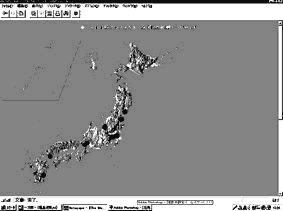 Initiated
by the CEC, the Live Camera Map of Japan is part of a program to share observation
data with other schools. Starting this year, our school will run this program.
We'd like to be able to send the latest weather information from all over
Japan, using live cameras stationed throughout the country. We hope to offer
basic information that will be helpful for studying the weather in science
classes, along with the images of clouds taken by the weather satellite Himawari.
Initiated
by the CEC, the Live Camera Map of Japan is part of a program to share observation
data with other schools. Starting this year, our school will run this program.
We'd like to be able to send the latest weather information from all over
Japan, using live cameras stationed throughout the country. We hope to offer
basic information that will be helpful for studying the weather in science
classes, along with the images of clouds taken by the weather satellite Himawari.
(2) "Nationwide Germination Map '97" (sophisticated use of school networking,
initiated by CEC)
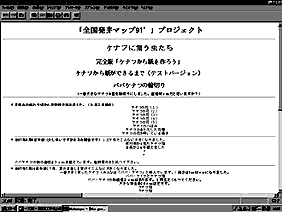 Since
the inception of the 100-School Networking Project, this three-year old program
has been run mainly by Elementary School attached to Faculty of Education
of Miyazaki University. This year, elementary schools in various locations
cultivated kenaf, an annual plant whose pulp can be substituted for uses which
normally require wood pulp, and which is attracting attention in the environmental
education field for its potential to protect forest resources. We harvested
kenaf in November, made paper and produced post cards, and exchanged New Year
cards with other schools participating in the project. We also participated
in a program called "Joint Production of a Picture Book," run by
Shimizu Kokusai Junior and Senior High School.
Since
the inception of the 100-School Networking Project, this three-year old program
has been run mainly by Elementary School attached to Faculty of Education
of Miyazaki University. This year, elementary schools in various locations
cultivated kenaf, an annual plant whose pulp can be substituted for uses which
normally require wood pulp, and which is attracting attention in the environmental
education field for its potential to protect forest resources. We harvested
kenaf in November, made paper and produced post cards, and exchanged New Year
cards with other schools participating in the project. We also participated
in a program called "Joint Production of a Picture Book," run by
Shimizu Kokusai Junior and Senior High School.
(3) Improved access for handicapped children (sophisticated use of school
networking, initiated by the CEC)
- Our school has two special classes for handicapped children. Participating
in Challenge Kids, a special network for handicapped children, children in
these classes correspond by e-mail with children from other schools. We borrowed
touch panels from the CEC, used touch-compatible software, set up a touch-panel
version home page, and did some research into such interfaces in order to
improve access to the network for handicapped children.
(4) Experiment using filtering software (IFS) (Program for the use of advanced
networking-technology, initiated by CEC)
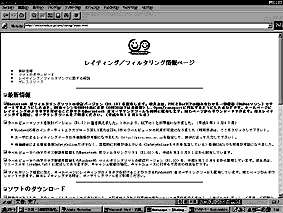 At
our school, we set up computers in regular classrooms to allow children free
access to the Internet. The first student to arrive at each classroom in the
morning turns the computer on, and the last child to go home turns it off.
Children access various sites and write e-mail during breaks. From the fourth
grade, students know how to use a search engine. To guard against the possibility
of their encountering educationally unsuitable sites, we have installed filtering
software (IFS) on each computer.
At
our school, we set up computers in regular classrooms to allow children free
access to the Internet. The first student to arrive at each classroom in the
morning turns the computer on, and the last child to go home turns it off.
Children access various sites and write e-mail during breaks. From the fourth
grade, students know how to use a search engine. To guard against the possibility
of their encountering educationally unsuitable sites, we have installed filtering
software (IFS) on each computer.
3. School-initiative program
(1) International research group http://www.hirano-es.otsu.shiga.jp/kokusai/
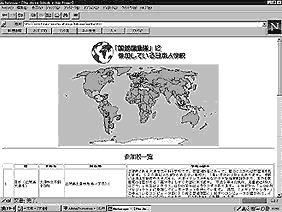 Last year,
the Overseas Japanese Children Education Division of the Ministry of Education
initiated a plan to network schools for Japanese children living abroad, using
the Internet. At our school, responding to a request from Japan Association
for Promotion of Education Technology (JAPET), we planned an educational project
based on this international network. We established a "conference room"
on our server, where Japanese schools from all over the world can contact
us, and conducted research on a global scale.
Last year,
the Overseas Japanese Children Education Division of the Ministry of Education
initiated a plan to network schools for Japanese children living abroad, using
the Internet. At our school, responding to a request from Japan Association
for Promotion of Education Technology (JAPET), we planned an educational project
based on this international network. We established a "conference room"
on our server, where Japanese schools from all over the world can contact
us, and conducted research on a global scale.
First, we researched consumer prices. Then, we explored the appearance of
the moon on the same day from different points on the globe, and the sun's
culmination altitude around the world. We would like to continue offering
such educational material next year, in efforts to increase international
understanding.
(2) A joint study of the story of "Gongitsune", via the Internet
http://www.hirano-es.otsu.shiga.jp/gon/gon.html
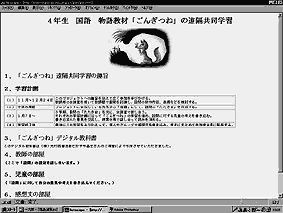 The
idea behind this program was to use the Internet to teach subjects that are
already taught in conventional ways, to see if a joint study such as this
could be implemented in a regular classroom. One goal in using the Internet
was to bring out children's diverse thoughts, and to improve and deepen each
student's reading abilities. Another goal was to improve collaboration between
teachers by sharing ideas about teaching materials and discussing types of
questions to ask children, via the Internet.
The
idea behind this program was to use the Internet to teach subjects that are
already taught in conventional ways, to see if a joint study such as this
could be implemented in a regular classroom. One goal in using the Internet
was to bring out children's diverse thoughts, and to improve and deepen each
student's reading abilities. Another goal was to improve collaboration between
teachers by sharing ideas about teaching materials and discussing types of
questions to ask children, via the Internet.
(3) A comprehensive study project for six graders, entitled "theme research"
http://www.hirano-es.otsu.shiga.jp/kadaikenkyu.html
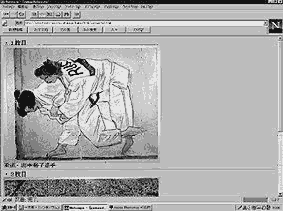 Six
graders worked on this program one hour each week (35 hours total). Each chose
a theme on which they did research throughout the year, and presented their
results in individual home pages. The themes chosen and the results of their
research varied widely, reflecting their individual traits and interests.
Student A, creator of the home page on the right, likes sports and drawing.
He summarized the results of the Atlanta Olympics, drew pictures, and made
woodcut prints commemorating the Olympics. He drew pictures on large drawing
paper, photographed them, and used a scanner to place them in his home page.
Six
graders worked on this program one hour each week (35 hours total). Each chose
a theme on which they did research throughout the year, and presented their
results in individual home pages. The themes chosen and the results of their
research varied widely, reflecting their individual traits and interests.
Student A, creator of the home page on the right, likes sports and drawing.
He summarized the results of the Atlanta Olympics, drew pictures, and made
woodcut prints commemorating the Olympics. He drew pictures on large drawing
paper, photographed them, and used a scanner to place them in his home page.
(4) Our School Research Classes, FY 1997
|
Grade
|
Subject
|
Unit name
|
URL
|
|
First grade
|
Life science
|
Exploring our school
|
http.//www.hirano-s.otsu.shiga.jp/class97/1tanken1.html
|
|
Second grade
|
Life science
|
Using various means of transportation
|
http.//www.hirano-es.otsu.shiga.jp/2s/2s-homea.html
|
|
Third grade
|
Science
|
The anatomy of insects
|
http.//www.hirano-es.otsu.shiga.jp/3r/31r/31r-home.html
|
|
Fourth grade
|
Japanese
|
Story of "Gongitsune"
|
http.//www.hirano-es.otsu.shiga.jp/gon/gon.html
|
|
Fifth grade
|
Environmental studies
|
Quiz on the earth's environment
|
http.//www.hirano-es.otsu.shiga.jp/kannkyou/kannkyou.html
|
|
Sixth grade
|
Social Studies
|
War and its effect on people's lives
|
http.//www.hirano-es.otsu.shiga.jp/kadaikenkyu.html
|
4. Conclusion
- In FY 1997, we strove to conduct classes that would teach every child how
to provide information across the Internet. In an atmosphere free of intimidation,
children learned to use a networking system. Using the Internet, they expressed
their opinions and thoughts freely. We are weighing the idea of providing
each child with a portable remote terminal, which would allow them to store
their own research and relate it to their study, using the school LAN.
 Conference to introduce results from the 100-School Networking Project (Phase II)
Conference to introduce results from the 100-School Networking Project (Phase II)
 Initiated
by the CEC, the Live Camera Map of Japan is part of a program to share observation
data with other schools. Starting this year, our school will run this program.
We'd like to be able to send the latest weather information from all over
Japan, using live cameras stationed throughout the country. We hope to offer
basic information that will be helpful for studying the weather in science
classes, along with the images of clouds taken by the weather satellite Himawari.
Initiated
by the CEC, the Live Camera Map of Japan is part of a program to share observation
data with other schools. Starting this year, our school will run this program.
We'd like to be able to send the latest weather information from all over
Japan, using live cameras stationed throughout the country. We hope to offer
basic information that will be helpful for studying the weather in science
classes, along with the images of clouds taken by the weather satellite Himawari.
 Since
the inception of the 100-School Networking Project, this three-year old program
has been run mainly by Elementary School attached to Faculty of Education
of Miyazaki University. This year, elementary schools in various locations
cultivated kenaf, an annual plant whose pulp can be substituted for uses which
normally require wood pulp, and which is attracting attention in the environmental
education field for its potential to protect forest resources. We harvested
kenaf in November, made paper and produced post cards, and exchanged New Year
cards with other schools participating in the project. We also participated
in a program called "Joint Production of a Picture Book," run by
Shimizu Kokusai Junior and Senior High School.
Since
the inception of the 100-School Networking Project, this three-year old program
has been run mainly by Elementary School attached to Faculty of Education
of Miyazaki University. This year, elementary schools in various locations
cultivated kenaf, an annual plant whose pulp can be substituted for uses which
normally require wood pulp, and which is attracting attention in the environmental
education field for its potential to protect forest resources. We harvested
kenaf in November, made paper and produced post cards, and exchanged New Year
cards with other schools participating in the project. We also participated
in a program called "Joint Production of a Picture Book," run by
Shimizu Kokusai Junior and Senior High School.  At
our school, we set up computers in regular classrooms to allow children free
access to the Internet. The first student to arrive at each classroom in the
morning turns the computer on, and the last child to go home turns it off.
Children access various sites and write e-mail during breaks. From the fourth
grade, students know how to use a search engine. To guard against the possibility
of their encountering educationally unsuitable sites, we have installed filtering
software (IFS) on each computer.
At
our school, we set up computers in regular classrooms to allow children free
access to the Internet. The first student to arrive at each classroom in the
morning turns the computer on, and the last child to go home turns it off.
Children access various sites and write e-mail during breaks. From the fourth
grade, students know how to use a search engine. To guard against the possibility
of their encountering educationally unsuitable sites, we have installed filtering
software (IFS) on each computer. Last year,
the Overseas Japanese Children Education Division of the Ministry of Education
initiated a plan to network schools for Japanese children living abroad, using
the Internet. At our school, responding to a request from Japan Association
for Promotion of Education Technology (JAPET), we planned an educational project
based on this international network. We established a "conference room"
on our server, where Japanese schools from all over the world can contact
us, and conducted research on a global scale.
Last year,
the Overseas Japanese Children Education Division of the Ministry of Education
initiated a plan to network schools for Japanese children living abroad, using
the Internet. At our school, responding to a request from Japan Association
for Promotion of Education Technology (JAPET), we planned an educational project
based on this international network. We established a "conference room"
on our server, where Japanese schools from all over the world can contact
us, and conducted research on a global scale. The
idea behind this program was to use the Internet to teach subjects that are
already taught in conventional ways, to see if a joint study such as this
could be implemented in a regular classroom. One goal in using the Internet
was to bring out children's diverse thoughts, and to improve and deepen each
student's reading abilities. Another goal was to improve collaboration between
teachers by sharing ideas about teaching materials and discussing types of
questions to ask children, via the Internet.
The
idea behind this program was to use the Internet to teach subjects that are
already taught in conventional ways, to see if a joint study such as this
could be implemented in a regular classroom. One goal in using the Internet
was to bring out children's diverse thoughts, and to improve and deepen each
student's reading abilities. Another goal was to improve collaboration between
teachers by sharing ideas about teaching materials and discussing types of
questions to ask children, via the Internet.  Six
graders worked on this program one hour each week (35 hours total). Each chose
a theme on which they did research throughout the year, and presented their
results in individual home pages. The themes chosen and the results of their
research varied widely, reflecting their individual traits and interests.
Student A, creator of the home page on the right, likes sports and drawing.
He summarized the results of the Atlanta Olympics, drew pictures, and made
woodcut prints commemorating the Olympics. He drew pictures on large drawing
paper, photographed them, and used a scanner to place them in his home page.
Six
graders worked on this program one hour each week (35 hours total). Each chose
a theme on which they did research throughout the year, and presented their
results in individual home pages. The themes chosen and the results of their
research varied widely, reflecting their individual traits and interests.
Student A, creator of the home page on the right, likes sports and drawing.
He summarized the results of the Atlanta Olympics, drew pictures, and made
woodcut prints commemorating the Olympics. He drew pictures on large drawing
paper, photographed them, and used a scanner to place them in his home page.
 Conference to introduce results from the 100-School Networking Project (Phase II)
Conference to introduce results from the 100-School Networking Project (Phase II)